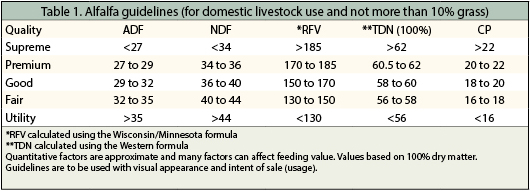Below are examples of alfalfa and grass prices being paid FOB barn/stack (except for those noted as delivered, which is indicated by a "d" in the table below) for selected states at the end of the day on Friday, February 22. Large ranges for a particular grade and state are often indicative of location and/or bale size. Also check the USDA Hay Market Prices for additional locations and more detailed information.



Hay Quality Designations physical descriptions:
Supreme: Very early maturity, pre-bloom, soft fine stemmed, extra leafy. Factors indicative of very high nutritive content. Hay is excellent color and free of damage.
Premium: Early maturity, i.e., pre-bloom in legumes and pre head in grass hays, extra leafy and fine stemmed-factors indicative of a high nutritive content. Hay is green and free of damage.
Good: Early to average maturity, i.e., early to mid-bloom in legumes and early head in grass hays, leafy, fine to medium stemmed, free of damage other than slight discoloration.
Fair: Late maturity, i.e., mid to late-bloom in legumes, head-in grass hays, moderate or below leaf content, and generally coarse stemmed. Hay may show light damage.


